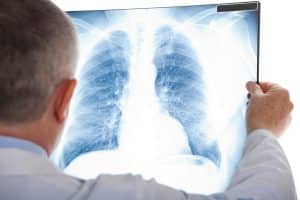Dangerous Lung Cancer Misdiagnoses Are More Common Than You Think
 When it comes to cancer, a delayed diagnosis can have a significant impact on a patient’s prognosis. This is particularly true for lung cancer, as the disease can spread rapidly and become more difficult to treat as time goes on. Unfortunately, lung cancer misdiagnoses are not uncommon. Many patients have experienced delayed or missed diagnoses because their doctors failed to recognize the significance of their symptoms. While patients rely on their physicians to make an accurate and timely diagnosis, the reality is that a significant number of medical diagnoses are missed each year, including those for serious and potentially fatal illnesses like lung cancer.
When it comes to cancer, a delayed diagnosis can have a significant impact on a patient’s prognosis. This is particularly true for lung cancer, as the disease can spread rapidly and become more difficult to treat as time goes on. Unfortunately, lung cancer misdiagnoses are not uncommon. Many patients have experienced delayed or missed diagnoses because their doctors failed to recognize the significance of their symptoms. While patients rely on their physicians to make an accurate and timely diagnosis, the reality is that a significant number of medical diagnoses are missed each year, including those for serious and potentially fatal illnesses like lung cancer.
How common are lung cancer misdiagnoses?
Misdiagnosis of lung cancer can have serious consequences for patients. Lung cancer is one of the most deadly cancers, and early diagnosis is crucial for successful treatment. Unfortunately, lung cancer is often misdiagnosed, leading to delayed treatment and potentially fatal outcomes.
One of the main reasons for misdiagnosis is the similarity of lung cancer symptoms to those of other respiratory illnesses. For example, a persistent cough and shortness of breath are symptoms of lung cancer, but they can also be symptoms of asthma, chronic bronchitis, or pneumonia. Doctors may also misdiagnose lung cancer as tuberculosis, which can have similar symptoms and imaging findings.
Another common cause of misdiagnosis is errors in interpreting imaging studies. Radiologists may miss small nodules or tumors on chest X-rays or CT scans, leading to a false-negative result. Alternatively, they may identify benign lung nodules as cancerous, leading to unnecessary biopsies or surgeries. Peter Baik, DO, Thoracic Surgeon at Cancer Treatment Centers of America admitted that “a basic X-ray isn’t going to be able to tell you whether it’s a tumor or pneumonia.”
Lung cancer misdiagnosis can also occur due to errors in the biopsy process. A biopsy is a procedure where a small sample of lung tissue is taken for examination under a microscope. If the biopsy sample is not taken from the cancerous area or is not large enough to make an accurate diagnosis, the cancer may be missed or misdiagnosed.
When pregnancy masks the signs of cancer
Jessica Sherrie, a 35-year-old woman from Glendora, California, experienced severe back pain during the last month of her pregnancy and assumed it was a result of a previous surgery and physical stress. However, the pain persisted after the birth of her daughter, Regina. After a series of tests, doctors informed Sherrie that she had stage 4 lung cancer that had spread throughout her body. Sherrie had non-small cell lung cancer, which is a less aggressive type of lung cancer, but tumors were found in her brain, hips, and spine, indicating that she had incurable stage 4 cancer. Sherrie had never smoked, which made the diagnosis even more surprising.
Non-small cell lung cancer affects approximately 80% to 85% of people with lung cancer, and people with stage 4 non-small cell lung cancer have a five-year survival rate of about one percent, according to the American Cancer Society. Treatment options for the cancer include surgery, chemotherapy, radiation therapy, and immunotherapy to relieve symptoms and prolong lifespan if the patient is in good health otherwise.
Sherrie’s doctor, Erminia Massarelli, MD, co-director of the City of Hope Comprehensive Cancer Center’s lung cancer and thoracic oncology program, stated that new treatments can help make certain late-stage cancers more manageable, treating it like a chronic disease that needs chronic treatment. Sherrie’s story highlights the significance of not ignoring health concerns, especially among young individuals who are not commonly linked with lung cancer.
What are the symptoms of lung cancer?
The American Cancer Society states that lung cancer symptoms include:
- Persistent cough
- Wheezing
- Coughing up blood
- Shortness of breath
- Infections (such as bronchitis and pneumonia that will not go away or keeps returning)
If the cancer spreads to other parts of the body, it may cause:
- Bone pain
- Swelling of lymph nodes
- Headaches
- Dizziness
- Weakness
- Numbness of a limb
- Jaundice
How can a South Carolina medical malpractice attorney help me?
If you or a loved one has been misdiagnosed with lung cancer, you may be entitled to compensation for medical expenses, lost wages, and pain and suffering. It is essential to consult an experienced medical malpractice attorney to evaluate your case.
An attorney can review your medical records and imaging studies to determine if there were any errors or omissions in your diagnosis and treatment. They can also consult with medical experts to determine the appropriate standard of care and whether your healthcare provider fell below that standard.
If your attorney determines that medical malpractice has occurred, they can file a lawsuit on your behalf. They will seek to recover damages to compensate you for the harm you have suffered, including medical expenses, lost wages, and pain and suffering.
Lung cancer misdiagnosis can have devastating consequences for patients and their families. If you or your loved one has been a victim of a diagnostic error, the experienced South Carolina medical malpractice attorneys at McGowan, Hood, Felder & Phillips, LLC are here to help. We have a proven track record of fighting for the rights of patients and their families in cases of medical negligence. To schedule a free consultation with one of our attorneys, you can call us at one of our many offices in South Carolina or use our contact page.
Related:

Randy is the former President of the South Carolina Association for Justice. He has been certified by the American Board of Professional Liability as a specialist in Medical Malpractice Law which is recognized by the South Carolina Bar. Randy has also been awarded the distinction of being a “Super Lawyer” 10 times in the last decade. He has over 25 years of experience helping injured people fight back against corporations, hospitals and wrong-doers.
Read more about S. Randall Hood

